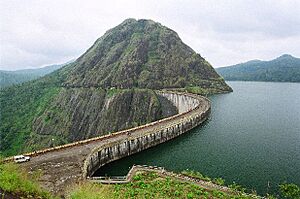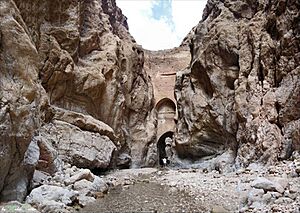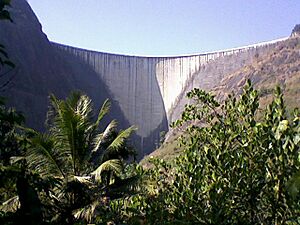Arch dam facts for kids
An arch dam is a special type of dam made of concrete. It's built with a curve that faces upstream, towards the water. This curve is super important! When the water pushes against the dam, the arch shape actually makes the dam stronger. It pushes the force of the water into the sides of the canyon or valley, which are called the 'abutments'.

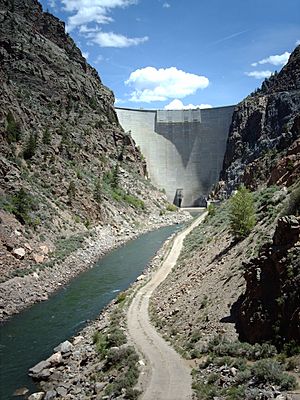
Arch dams are perfect for narrow canyons or gorges that have strong, stable rock walls. Because of their clever design, they use less building material than other types of dams. This makes them a good choice for places that are far away and hard to reach.
Contents
History of Arch Dams
Arch dams have a long and interesting history, going back thousands of years!
Ancient Arch Dams
The ancient Romans were some of the first to build arch dams. The earliest known one, called the Glanum Dam, was built in France around 100 BC. It was about 12 meters (39 feet) high. The Romans built it to bring water to a nearby town called Glanum.
Another Roman arch dam, the Monte Novo Dam in Portugal, was built around 300 AD. It was 5.7 meters (19 feet) high. A historian named Procopius wrote about the Dara Dam, another Roman arch dam. He said its curved shape helped it resist the river's strong current even better.
The Mongols also built arch dams in what is now Iran. The Kebar Dam was built around 1300. It was 26 meters (85 feet) high. Their second dam, the Kurit Dam, built around 1350, became the tallest dam in the world for a long time after more was added to it in 1850. It was 64 meters (210 feet) tall! The Kurit Dam was made of stone and built in a very narrow canyon. It's still standing today!
In Spain, the Tibi Dam was built between 1579 and 1594. It was 42.7 meters (140 feet) high and was the first arch dam in Europe since the Romans.
Modern Arch Dams
In the early 1900s, engineers started building even more advanced arch dams. The world's first variable-radius arch dam was built on the Salmon Creek in Alaska. This dam had a special shape that helped spread out the pressure from the water. This new design allowed for much larger and taller dams to be built.
In 1920, a Swiss engineer named Alfred Stucky came up with new ways to calculate how arch dams should be built. He used ideas from elasticity to make the dams even stronger and more efficient.
The Pensacola Dam in Oklahoma, finished in 1940, was one of the longest multiple-arch dams in the United States. It had 51 arches!
Engineers kept pushing the limits of arch dam design. In the 1960s, they developed ways to build "double-curved" dams, like the Morrow Point Dam in Colorado. These dams curve both horizontally and vertically, making them incredibly strong.
Today, the tallest arch dam in the world is the Jingpin-I Dam in China, which is an amazing 305 meters (1,001 feet) tall! It was finished in 2013. The longest multiple-arch dam is the Daniel-Johnson Dam in Quebec, Canada. It's 214 meters (702 feet) high and 1,314 meters (4,311 feet) long across its top.
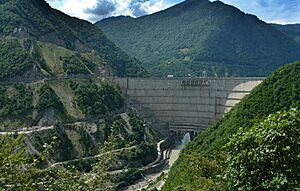
How Arch Dams are Designed
Designing an arch dam is a very detailed process. Engineers start with an idea and keep improving it until the dam meets all the safety and building rules.
Forces on a Dam
Engineers have to think about many forces when designing an arch dam:
- Dead load: This is the weight of the dam itself.
- Hydrostatic load: This is the force of the water in the reservoir pushing against the dam.
- Temperature load: Dams can expand and shrink with changes in temperature, so this must be considered.
- Earthquake load: Dams must be strong enough to withstand earthquakes.
Other things like ice, silt (mud and sand), and water pressure from underneath the dam also need to be thought about.
Most arch dams are made of concrete and are built in V-shaped valleys. The rock walls where the dam connects must be very strong.
There are a few main types of arch dam designs:
- Constant-radius dams: These dams have the same curve from top to bottom.
- Variable-radius dams: The curve of these dams changes as you go down from the top.
- Double-curved dams: These dams curve both horizontally (side to side) and vertically (up and down). They are sometimes called dome dams.
Some dams have more than one arch connected together. These are called multiple-arch dams. Examples include the Roman Esparragalejo Dam and the Daniel-Johnson Dam. However, after a dam called the Gleno Dam failed in 1923, fewer new multiple-arch dams have been built.
Types of Arch Dams
Here are the main types of arch dams based on their shape:
- Constant radii arch dam: The front face of this dam has the same curve all the way up. But the inner curves get smaller as you go down.
- Variable arch dam: Both the inner and outer curves of this dam change from top to bottom. The curve is widest at the top and narrowest at the bottom.
- Constant angle arch dam: This type is often the most cost-effective to build. In this design, the angle of the horizontal arches stays the same at all heights.
Examples of Arch Dams

- Buchanan Dam (a multiple-arch type)
- Contra Dam
- Daniel-Johnson Dam
- Deriner Dam
- El Atazar Dam
- Enguri Dam
- Flaming Gorge Dam
- Glen Canyon Dam
- Hartbeespoort Dam
- Idukki Dam
- Kariba Dam
- Karun-3 Dam
- Luzzone Dam
- Mauvoisin Dam
- Mratinje Dam
- New Bullards Bar Dam
- Pensacola Dam
- St. Francis Dam
- Victoria Dam
- Xiluodu Dam
- Hoover Dam
- Bhumibol Dam
See Also
- Arch-gravity dam
- Gravity dam
- Parabolic arch


